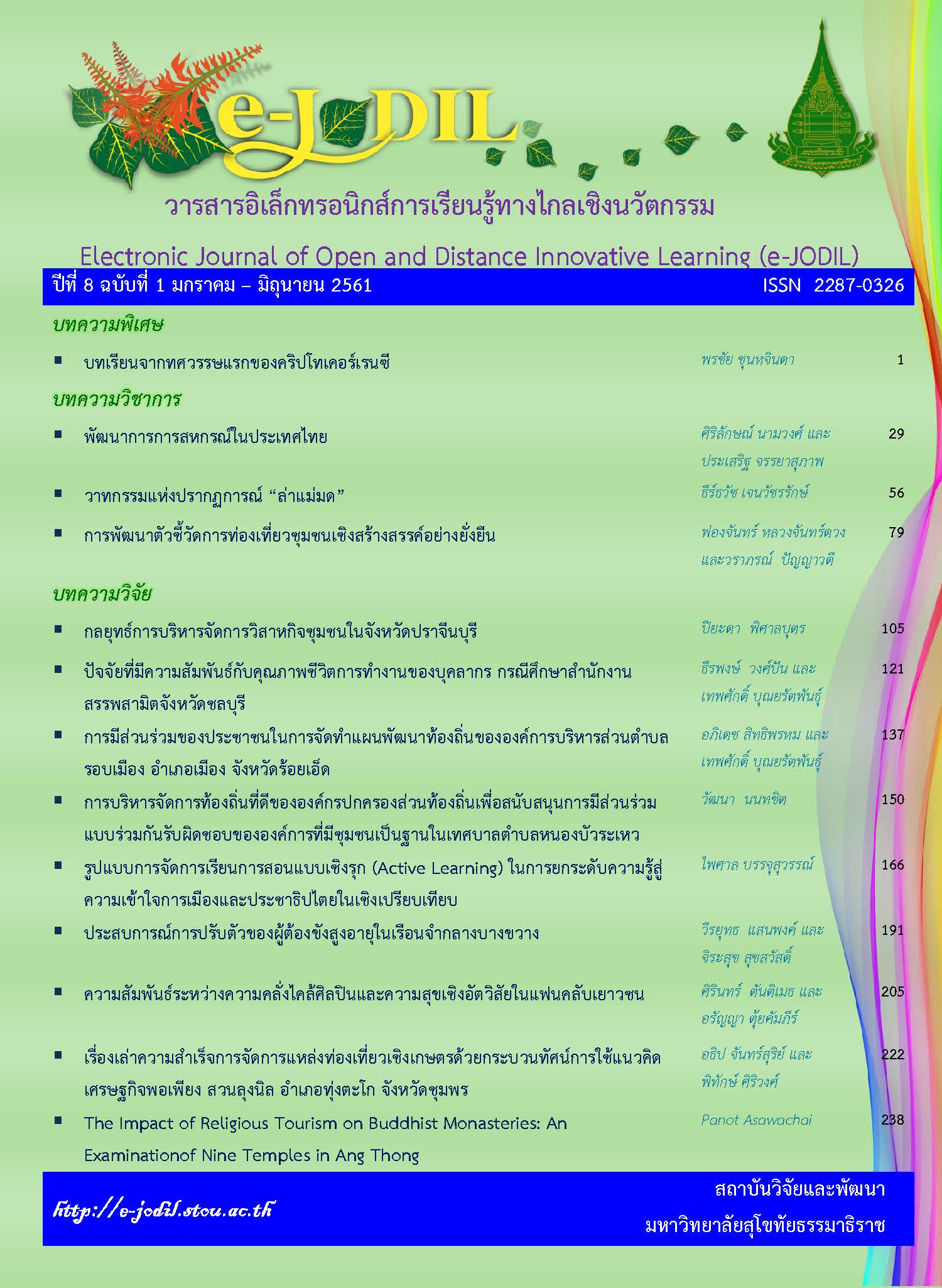The Impact of Religious Tourism on Buddhist Monasteries: An Examination of Nine Temples in Ang Thong
Main Article Content
บทคัดย่อ
In this research, the impact of religious tourism development on the cultural heritage of sacred Buddhist places is analyzed through an examination of nine temples in Ang Thong and their communities. The research considers strategies that might permit religious tourism development while conserving the cultural heritage significance of the places. The research methodologies of this research is conducted by using literature research, field observation, in-depth interview and participatory research. A review of tourism impacts by assessing and studying nine sacred temples’ cultural heritage is undertaken to develop a practicable approach to promoting and managing tourism sustainably. The research is found that tourism brings positive and negative impacts on Buddhist monasteries and their communities. The major positive impacts are contributions to local development in transportation infrastructure, generation of income and employment, and promotion of local culture. The major negative impacts are inequality of income distribution, seasonal jobs and commercialization or commodification of Buddhism. Cultural heritage education and conservation awareness is needed by abbots, monks and communities. It should be strictly applied as a policy. Moreover, the qualification of selection of monk for the Samanasak must be revised and ability in constructing and promoting material things in the temple compound should not be considered. Furthermore, abbot, monks, host communities, the government sector, tourists, media and the voluntary sector must be involved in safeguarding the culture heritage significance of the nine sacred temples and their communities in order to manage the tourism more sustainably.
Downloads
Article Details
บทความ ข้อความ ภาพประกอบ ตารางประกอบ ที่ตีพิมพ์ในวารสารเป็นความคิดเห็นและความรับผิดชอบของผู้เขียนแต่เพียงผู้เดียว ไม่เกี่ยวข้องกับมหาวิทยาลัยสุโขทัยธรรมาธิราชแต่อย่างใด
บทความที่เสนอพิจารณาในวารสาร e-JODIL ต้องเป็นบทความที่ไม่เคยส่งไปลงพิมพ์ เผยแพร่ หรืออยู่ระหว่างการพิจารณาของวารสารอื่น
กองบรรณาธิการขอสงวนสิทธิ์ในการพิจารณาและตัดสินการตีพิมพ์บทความในวารสาร
เอกสารอ้างอิง
Damrong Rajanubhab Prince. (1959). Thesaphiban (Provincial administration). Bangkok: Klang Wittaya.
Damrong Rajanubhab Prince. (1960). Ruang Phra Ruang (History of Sukhothai Dynasty). Bangkok: Klang Wittaya.
Damrong Rajanubhab Prince. (1968). Phraratcha Phohgsawasan Chabab Phraratchachatckha (Annals autograph edition by King Mongkut). Bangkok: Klang Wittaya.
Hanna, Max, Tyrell Marris and Jenny Lefley. (1979). English Cathedrals and Tourism: problems and opportunities. London: English Tourist Board.
Ishii Yoneo. (1986). Sangha, State, and Society Thai Buddhism in history translated by Peter Hawkes. Kyoto: The University of Hawaii Press..
Mason Peter. (2003). Tourism Impacts, Planning and Management. Burlington: Butterworth-Heinemann. Olsen, Daniel H. (2003). “Heritage, Tourism, and the Commodification of Religion”. Tourism Recreation Resreach 28: 99-104.
Pintupan, Huan. (1971). Our Ang Thong. Bangkok. Odeon Store Publishing.
Punyasingh, Temsiri. (1981). Buddhism in Thai life. Bangkok: The National Identity Board.
Rinschede, Gisbert. (1992). “Forms of religious tourism”. Annals of Tourism Research 19: 51-67.
Rotherham, Ian D. (2007). “Sustaining tourism infrastructures for religious tourists and pilgrims within the UK”. In: Raj, Razaq and Nigel D. Morpeth (eds): Religious Tourism and Pilgrimage Festivals Management: an international perspective. CABI: Wallingford, Cambridge/Mass, 64-77.
Shackley, Myra. (2001). Managing Sacred Sites: Service provision and visitor experience. London Continuum.
Suksamran, Somboon. (1982). Buddhism and Politics in Thailand. Singapore: Institute of Southeast Asian Studies.
Swarbrooke, John. (1998). Sustainable Tourism Management. Wallingford, Cambridge/Mass: CABI.
The Fine Arts Department. (1999). Cultural Development in History, Uniqueness and Local wisdom of Ang Thong Province. Bangkok, Khurusapha Publishing.
Woodward, Simon C. (2004). “Faith and tourism: planning tourism in relation to places of worship”.Tourism and Hospitality Planning & Development 1: 173-86.


